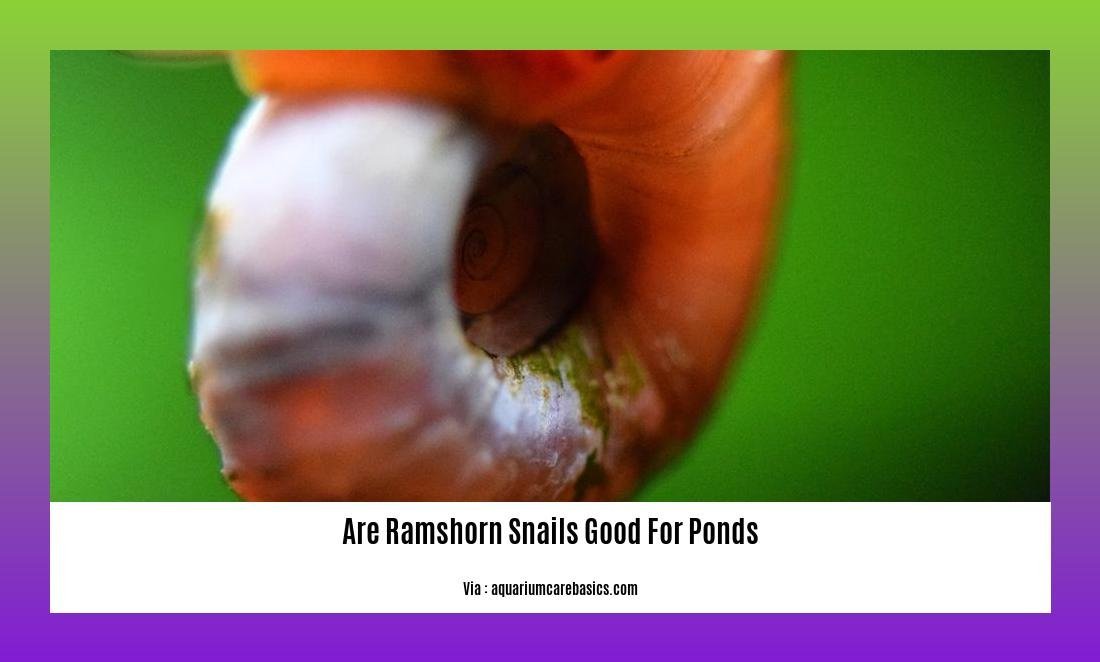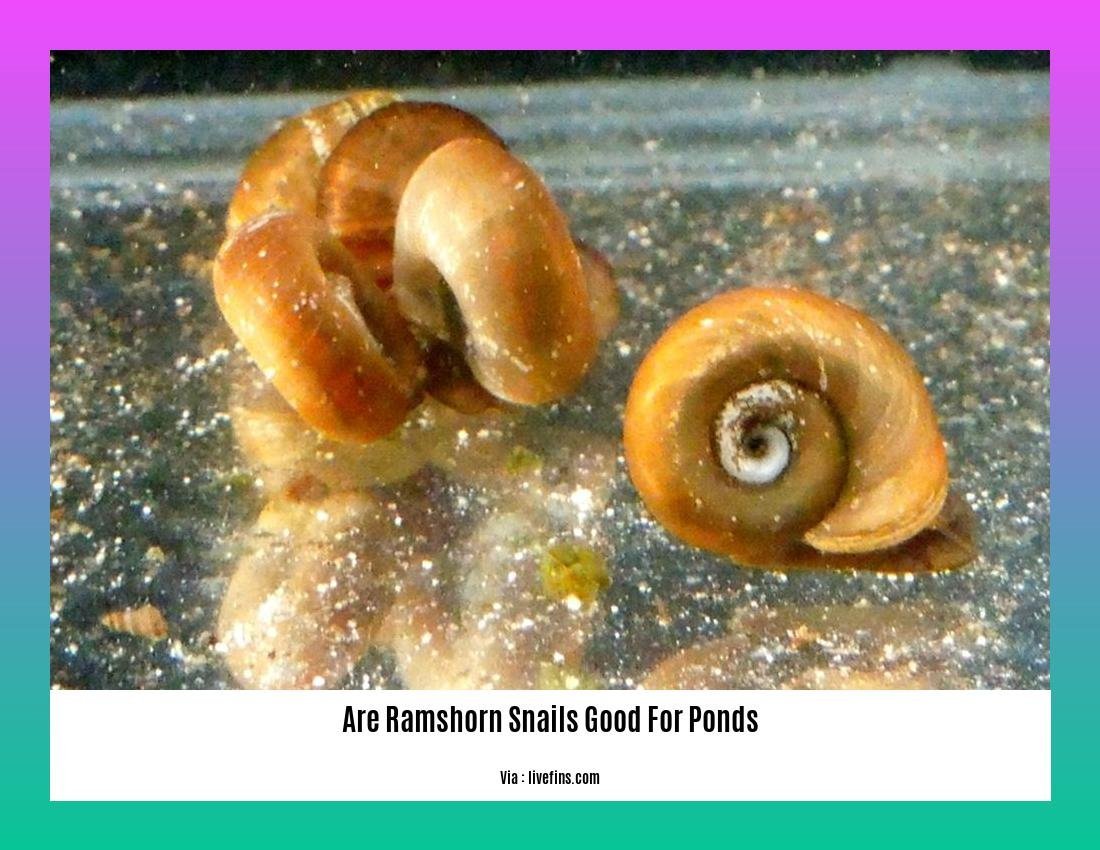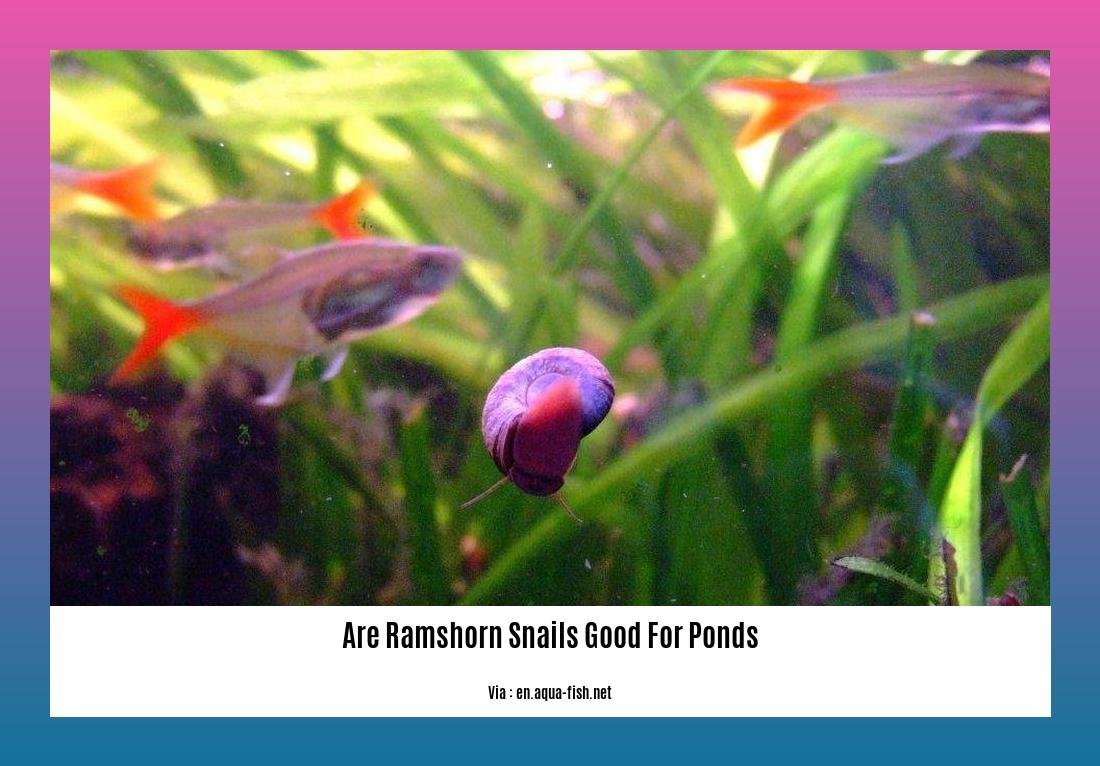Welcome to our comprehensive guide on the benefits of Ramshorn Snails in ponds. In this article, we will explore the intriguing world of these fascinating creatures and shed light on their importance in maintaining a healthy pond ecosystem. From their natural habitat and origins to discussing their role in breeding and the potential threats they face from predators, we aim to provide you with valuable insights into the question: Are Ramshorn Snails good for ponds?
Key Takeaways:
- Ramshorn snails are small molluscs that are beneficial for pond ecosystems.
- They help maintain the ecological balance by feeding on dead plants and algae, which keeps the water clear.
- Ramshorn snails can be found in ponds of all sizes, from small tub-style ponds to larger ones.
- Their population can multiply rapidly as they lay eggs instead of giving birth to live young.
- While they are beneficial, some people consider them to be a nuisance.
- Ramshorn snails can feed on various sources, including dead plants, algae, and the food provided in the pond.
- They can benefit from grazing areas provided by live plants, which help keep the water clean.
- It is important to manage the population of Ramshorn snails if they become overly abundant.
- They are not considered invasive species.
- To care for Ramshorn snails, provide a balanced diet that includes algae, vegetables, and protein-rich foods.
- Softening fruit before consumption may be necessary.
- Proper feeding and population control measures are necessary to manage Ramshorn snails in ponds.
Are Ramshorn Snails Good for Ponds?

Ramshorn snails, with their distinctive ram’s horn-shaped shells, are a valuable addition to pond ecosystems. These small molluscs offer several benefits that contribute to a balanced and healthy pond environment. Through their feeding habits and ability to reproduce rapidly, Ramshorn snails assist in maintaining the ecological equilibrium of ponds. However, it is essential to consider the potential drawbacks and cultivate a nuanced approach to managing their populations.
The Benefits of Ramshorn Snails
One of the primary advantages of having Ramshorn snails in ponds is their role in keeping the water clear. These snails are efficient consumers of dead plants and algae, which contribute to the growth of organic matter in the pond. By feeding on this detritus, Ramshorn snails help prevent excessive nutrient buildup, improving water quality and clarity.
Moreover, Ramshorn snails can thrive in ponds of various sizes. Whether you have a small tub-style pond or a larger one, these snails adapt well to their surroundings. This flexibility makes them suitable for a wide range of pond setups, ensuring that their benefits can be enjoyed by pond enthusiasts of all levels.
Considerations and Management
While Ramshorn snails bring numerous benefits, it is crucial to be aware of certain considerations. One such consideration is their reproductive capabilities. Ramshorn snails lay eggs rather than giving birth to live young. This means that their population can rapidly increase under favorable conditions, potentially leading to overcrowding.
To effectively manage the population of Ramshorn snails, controlling their food sources is crucial. Providing a balanced diet that includes algae, vegetables, and protein-rich foods is recommended. Additionally, grazing areas provided by live plants can help regulate the snail population by utilizing excess nutrients in the water column.
Are Ramshorn Snails Invasive?
It’s important to note that Ramshorn snails are not considered invasive species. While their population can multiply quickly, they do not pose a significant threat to native species or disrupt the natural balance of ecosystems. However, it is still essential to monitor their population density, taking appropriate measures if the population becomes overly abundant to reduce any potential negative impacts.
Conclusion
In conclusion, Ramshorn snails provide numerous benefits to pond ecosystems. Their ability to consume dead plants and algae helps maintain water clarity and quality, contributing to a healthy and balanced pond environment. These snails can adapt to ponds of various sizes, making them versatile companions for pond enthusiasts. To ensure their population remains in control, proper feeding and population management are necessary. By considering the benefits and limitations of Ramshorn snails, pond owners can make informed decisions about introducing these molluscs to their ponds, effectively contributing to a thriving aquatic ecosystem.
Are you wondering if slugs and snails are dangerous to dogs? Find out the truth about their potential harm to your canine companion by clicking here.
Curious about whether slugs and snails can be harmful to dogs? Discover the facts about their potential impact on your four-legged friend by visiting this link.
Concerned about the poisonous effects of slugs and snails on dogs? Learn more about the risks they pose to your beloved pet by clicking here.
Breeding Pond Snails

Ramshorn snails, with their unique appearance and intriguing behavior, have become a popular choice for pond enthusiasts. If you’re considering introducing these snails into your pond, it’s important to understand their breeding habits and the implications of their presence. In this article, we will delve into the world of breeding pond snails, exploring their life cycle, advantages, and considerations. So, let’s dive in!
The Fascinating Life Cycle of Pond Snails
Breeding pond snails, including ramshorn snails, involves a complex and intriguing life cycle. These snails are hermaphrodites, meaning they possess both male and female reproductive organs. When two snails come together, they exchange sperm, after which they go their separate ways to lay eggs. This interesting process contributes to their ability to quickly increase in population, making it essential to manage their numbers if they become too abundant.
Advantages of Breeding Pond Snails
When it comes to the benefits of breeding pond snails, there are several factors to consider. These snails play a crucial role in maintaining the ecological balance of a pond. They are known to feed on dead plants and algae, helping to keep the water clear and the pond ecosystem in harmony. Additionally, ramshorn snails are suitable for ponds of any size, from small tub-style ponds to larger ones. Their capability to adapt and thrive in a variety of pond environments makes them an attractive choice for pond owners.
Considerations for Breeding Pond Snails
While the advantages of breeding pond snails are apparent, it’s essential to be aware of potential considerations as well. Some pond owners may consider ramshorn snails to be a nuisance due to their ability to multiply rapidly. Although they are not considered invasive species, their population growth can pose challenges if left unmanaged. Therefore, it is crucial to monitor and control their numbers to maintain the overall health and balance of your pond ecosystem.
Caring for Breeding Pond Snails
Taking care of breeding pond snails is relatively straightforward. These resilient creatures are well-suited for beginners and require minimal care. Providing them with a balanced diet that includes algae, vegetables, and protein-rich foods is essential for their well-being. Additionally, they may benefit from grazing areas provided by live plants, which can help keep the water clean by utilizing nutrients in the water column. Softening certain fruits before consumption may also be necessary. With proper attention to their dietary needs and population management, breeding pond snails can thrive in your pond for several years.
Key Takeaways:
- Breeding pond snails, such as ramshorn snails, have a fascinating life cycle, with hermaphroditic reproductive organs.
- The advantages of breeding pond snails include their ability to feed on dead plants and algae, contributing to clear water and a balanced pond ecosystem.
- Considerations for breeding pond snails involve their potential population growth and the need for proper management to prevent overabundance.
- Caring for breeding pond snails entails providing a balanced diet, utilizing live plants for grazing areas, and maintaining population control measures.
Sources:
– Remodel or Move. (URL: Can Ramshorn snails survive in a pond?)
– Pond Academy. (URL: Pond Snails: Good or Bad for Your Pond? (Pros & Cons of Snails))
Pond Snails: Natural Habitat and Origins
Pond snails are fascinating creatures that inhabit freshwater ecosystems such as ponds, lakes, rivers, and canals all around the world. These small molluscs, including the popular Ramshorn snails, have a unique life cycle and play a significant role in maintaining the ecological balance of ponds. In this article, we will explore the natural habitat and origins of these intriguing pond snails.
The Habitat of Pond Snails
Pond snails, including Ramshorn snails, thrive in a variety of freshwater environments, adapting to their specific habitat requirements. They can be found in both natural and man-made ponds, as well as other bodies of water such as lakes and rivers. These hardy snails can withstand a range of temperature conditions, with some species even able to survive in cold temperatures.
Origins of Pond Snails
The origins of pond snails can be traced back to various regions across the globe. While some species of pond snails are native to certain regions, others have been introduced to new areas through human activities. It’s essential to be mindful of the specific species of pond snails in order to protect native ecosystems and prevent the introduction of invasive species.
Pond snails, including Ramshorn snails, have been widely distributed due to their ability to attach their eggs to aquatic plants, decor, or other objects that can be easily transported. This has resulted in the establishment of these snails in freshwater habitats worldwide.
Key Takeaways:
- Pond snails, including Ramshorn snails, are found in freshwater environments such as ponds, lakes, rivers, and canals.
- They are adaptable to various habitat conditions, with some species able to survive in cold temperatures.
- The origins of pond snails can be both natural and introduced through human activities.
- It is important to be aware of the specific species of pond snails to protect native ecosystems and prevent the spread of invasive species.
Now that we have explored the natural habitat and origins of pond snails, we can gain a deeper understanding of the role they play in pond ecosystems.
FAQ
Q1: What are Ramshorn snails?
A1: Ramshorn snails are small molluscs that play a beneficial role in ponds by feeding on dead plants and algae. Their shell shape resembles a ram’s horn.
Q2: Are Ramshorn snails good for ponds?
A2: Yes, Ramshorn snails are good for ponds as they help control algae and keep the water clear. They are suitable for ponds of any size.
Q3: Can Ramshorn snails become a nuisance?
A3: While Ramshorn snails are beneficial in maintaining the ecological balance of a pond, some people consider them to be a nuisance due to their rapid population increase.
Q4: How can the population of Ramshorn snails be managed?
A4: If the population of Ramshorn snails becomes overly abundant, it may need to be managed. Providing a balanced diet and practicing population control measures can help manage their population.
Q5: What do Ramshorn snails eat?
A5: Ramshorn snails can feed on various sources, including dead plants, algae, and the food provided in the pond. They can also benefit from grazing areas provided by live plants.
- Guatemala vs. Costa Rica: Plan Your Trip Smartly - April 16, 2025
- Master Types of Pumps: Ultimate Guide to Selection - April 16, 2025
- Unlock Types of Makeup Secrets: Master Any Look Now - April 16, 2025
















